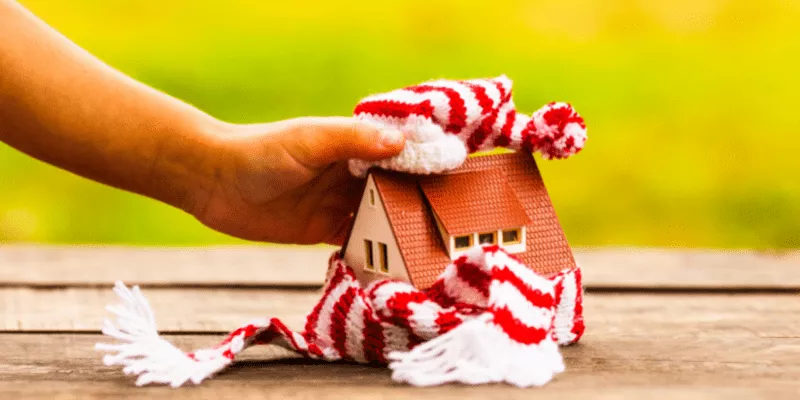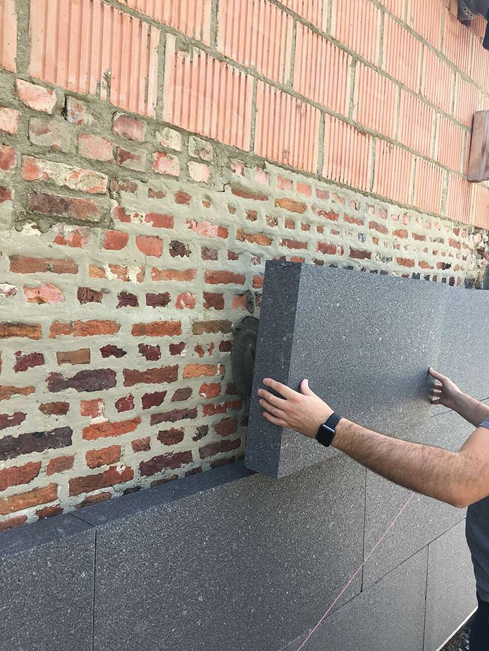Insulating or post-insulating your exterior facade is always a win-win solution.
With rising energy prices and high premiums, it is now more interesting than ever to insulate facades!
 If you want to save on your energy costs, insulating your façade is one of the most efficient solutions for reducing energy consumption in a sustainable way. Less energy consumption also means less consumption of e.g. fuel oil, gas, etc., so less emission of harmful substances, so better for the environment.
If you want to save on your energy costs, insulating your façade is one of the most efficient solutions for reducing energy consumption in a sustainable way. Less energy consumption also means less consumption of e.g. fuel oil, gas, etc., so less emission of harmful substances, so better for the environment.
This can be done in both new buildings and renovations.
Combined with our various facade finishes, we make your new construction or renovation project look beautiful.
With external façade insulation, you create a seamless, closing insulation shell without thermal bridges. By keeping the heat in and the cold out, you save a lot on your energy bill.
By insulating your house, your facade will have a totally new appearance and will be well protected against frost, moisture, dirt, etc. Problems with e.g. leaking moisture belong to the past. By insulating your exterior walls, you protect the underlying structure against all weather influences such as precipitation, heat (summer) and freezing temperatures, thus preventing thermal breaks, cold bridges, condensation and frost damage.
 External wall insulation is definitely a suitable choice:
External wall insulation is definitely a suitable choice:
 At Bomuur, the rules for installing an external wall insulation system are carefully followed and applied.
At Bomuur, the rules for installing an external wall insulation system are carefully followed and applied.
An exterior wall insulation system is indeed a fully-fledged system. All components are precisely matched to each other and implementation requires professional knowledge. After all, exterior wall insulation involves more than just fixing some insulation material to the walls. Accurate execution and correct installation are crucial to avoid air leaks, temperature fluctuations, condensation and thermal bridges!
This system is also known as ETICS.
(External Thermal Insulation Composite System).
Various components are applied directly to the façade, layer by layer. We distinguish between the adhesive layer, the insulation material, plugs (if necessary), reinforcement layer with glass-fibre reinforcement, adhesive primer, the finishing layer and all accessories such as the necessary profiles, etc...
All these system components are purchased from the same supplier, which also guarantees the system and its guarantee!
Bomuur works with grey EPS insulation boards, (expanded polystyrene with graphite), with an insulation or lambda value of 0.032 W/(m.K).
It is an insulation board made of expanded polystyrene rigid foam. The material contains numerous closed air bubbles with stagnant air inside. They are installed against the existing external wall in the form of rigid panels. They are either glued or bonded and plugged against the load-bearing wall.
EPS exterior wall insulation can be finished with numerous materials such as crepi or spray cork.
EPS is also known as Tempex or Styrofoam insulation. It is short for expanded polystyrene. The insulating effect of the boards is mainly due to the stagnant air stored in them.
EPS has the advantage of being very light in weight. This makes this insulation easy to lift and install.
EPS is made of expanded polystyrene and is popularly known as Styrofoam. One cubic metre of EPS contains more than 10 million individual polystyrene spheres. Furthermore, these spheres contain more than 2,500 air-filled compartments. Due to this structure, EPS is 98% air and only 2% polystyrene.
EPS works extremely well for thermal insulation because of the stagnant air stored in the boards. This is because stagnant air is extremely suitable as insulator.
EPS is lightweight, does not cause skin irritation, pressure-resistant, long-lasting, (H)CFC-free and environmentally friendly: Because EPS consists of only one type of material, EPS is an insulation material that can be recycled over and over again (100% recyclable), rot- and mould-free and water-repellent.

Step 1 of the 10-step plan: Request a no-obligation quote.
We will contact you as soon as possible and arrange the next 9 steps.